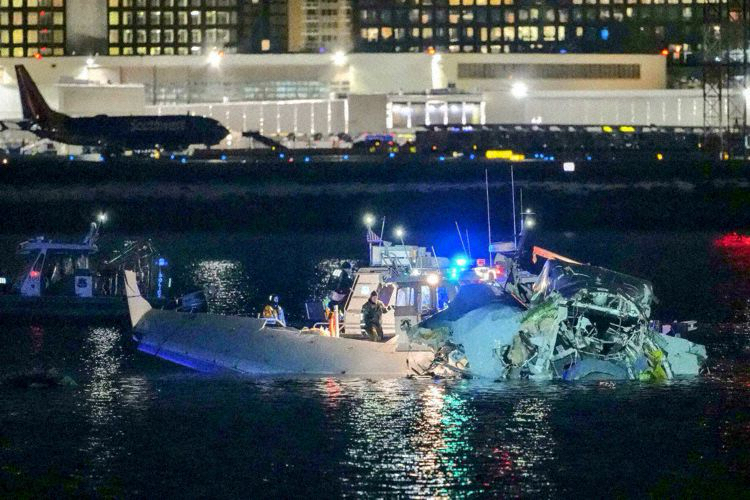Overview
• Operator: PSA Airlines on behalf of American Airlines
• Aircraft Model: Canadair CRJ-700
• Registration: N709PS
• Flight Number: AA-5342
• Route: Wichita, KS (USA) → Washington National, DC (USA)
• Date: 29 January 2025
• Occupants: 64 (60 passengers, 4 crew)
• Other Aircraft: Sikorsky UH-60 Black Hawk Helicopter
• Call Sign: PAT25
• Occupants of Helicopter: 3 crew members
• Location: Potomac River, near Washington National Airport (DCA)
• Fatalities: 67 (all occupants of both aircraft)
• Nature of Incident: Midair collision on final approach
Incident Summary
PSA Airlines Flight AA-5342, operated by a Canadair CRJ-700 (N709PS), was on approach to Washington National Airport (DCA) when air traffic control (ATC) offered a runway change from Runway 01 to Runway 33, which the crew accepted. The aircraft was on final approach to Runway 33, descending through 200 feet AGL, when it collided with a military Sikorsky UH-60 Black Hawk helicopter (PAT25) approximately 0.6 nautical miles from the runway threshold.
Both aircraft crashed into the Potomac River at 20:46 local time (01:46Z 30.1.). All 67 people aboard both aircraft perished in the accident.
The airport was immediately closed, and all departures were halted.
Sequence of Events
Final Approach & Collision
• The CRJ-700 was cleared for Runway 01 but was later reassigned to Runway 33.
• ATC was coordinating both the CRJ-700 and the UH-60 helicopter, which was following a military training route near the airport.
• ATC issued a traffic advisory to the CRJ crew, but collision avoidance measures were insufficient.
• The aircraft collided approximately 200 feet above the Potomac River.
• The CRJ-700 rolled beyond 90 degrees belly-up before crashing.
• Both aircraft fell into the water and caught fire upon impact.
Emergency Response
• ATC alerted emergency services immediately.
• Rescue helicopters and boats were dispatched to the crash site.
• Weather conditions were challenging, with cold temperatures causing a short survival window of 15–30 minutes.
• 300 personnel were deployed for search and rescue, but no survivors were found.
Investigation & Preliminary Findings
NTSB & FAA Statements
• The NTSB launched a full-scale investigation, retrieving cockpit voice recorders (CVR) and flight data recorders (FDR) from both aircraft.
• Preliminary data suggests ATC provided a traffic advisory to the CRJ-700 crew, but there was no immediate response from the UH-60 helicopter.
• The Black Hawk crew was on a military route but may not have been fully aware of the CRJ-700’s proximity.
• Both aircraft were within 100 feet vertically at impact.
• The CRJ-700 received a “TRAFFIC! TRAFFIC!” alert on TCAS just before impact.
• The CRJ-700 pitched up one second before impact, indicating the crew attempted evasive action.
Black Box Recovery
• The FDR from the CRJ-700 was intact and successfully retrieved.
• The CVR of the Black Hawk suffered water intrusion, requiring additional efforts to extract the data.
• NTSB has confirmed that the helicopter was operating at approximately 300 feet, consistent with its military flight path.
Potential Causes
1. Lack of Separation Between Aircraft
• ATC coordination between civilian and military traffic may have been inadequate.
• The CRJ-700 was cleared to land while the helicopter was transitioning airspace.
2. Communication Breakdown
• The Black Hawk crew may not have received or acknowledged ATC’s instructions in time.
• Conflicting altitude reports between the helicopter’s pilot and instructor are under review.
3. Low Visibility & Approach Complexity
• The Black Hawk crew may have been using night vision goggles, which could have limited situational awareness.
• The CRJ-700 crew only had seconds to react before impact.
Safety Recommendations & Preventative Measures
1. Review of ATC Procedures at Washington National Airport
• Improve separation standards for mixed civilian and military air traffic.
• Enhance real-time coordination between ATC and military air units.
2. Implementation of Mandatory Altitude & Flight Path Restrictions
• Establish clearer altitude separation rules for military and commercial aircraft near major airports.
• Improve airspace management near Washington National, where complex approaches exist.
3. Advanced Traffic Collision Avoidance Training
• Mandate enhanced collision avoidance training for both commercial and military pilots.
• Ensure TCAS (Traffic Collision Avoidance System) alerts are effectively responded to in critical situations.
Current Status & Next Steps
• The NTSB has completed on-scene investigations.
• A full transcript of ATC communications is being analyzed.
• Final altitude readings from both aircraft are under review.
• The final accident report is expected within 6–12 months.
Disclaimer
This report is based on available information as of 14 February 2025. While every effort has been made to ensure accuracy, the completeness of the details cannot be guaranteed. If you are the rightful owner of any referenced materials and wish them removed, please email takedown@cockpitking.com.
